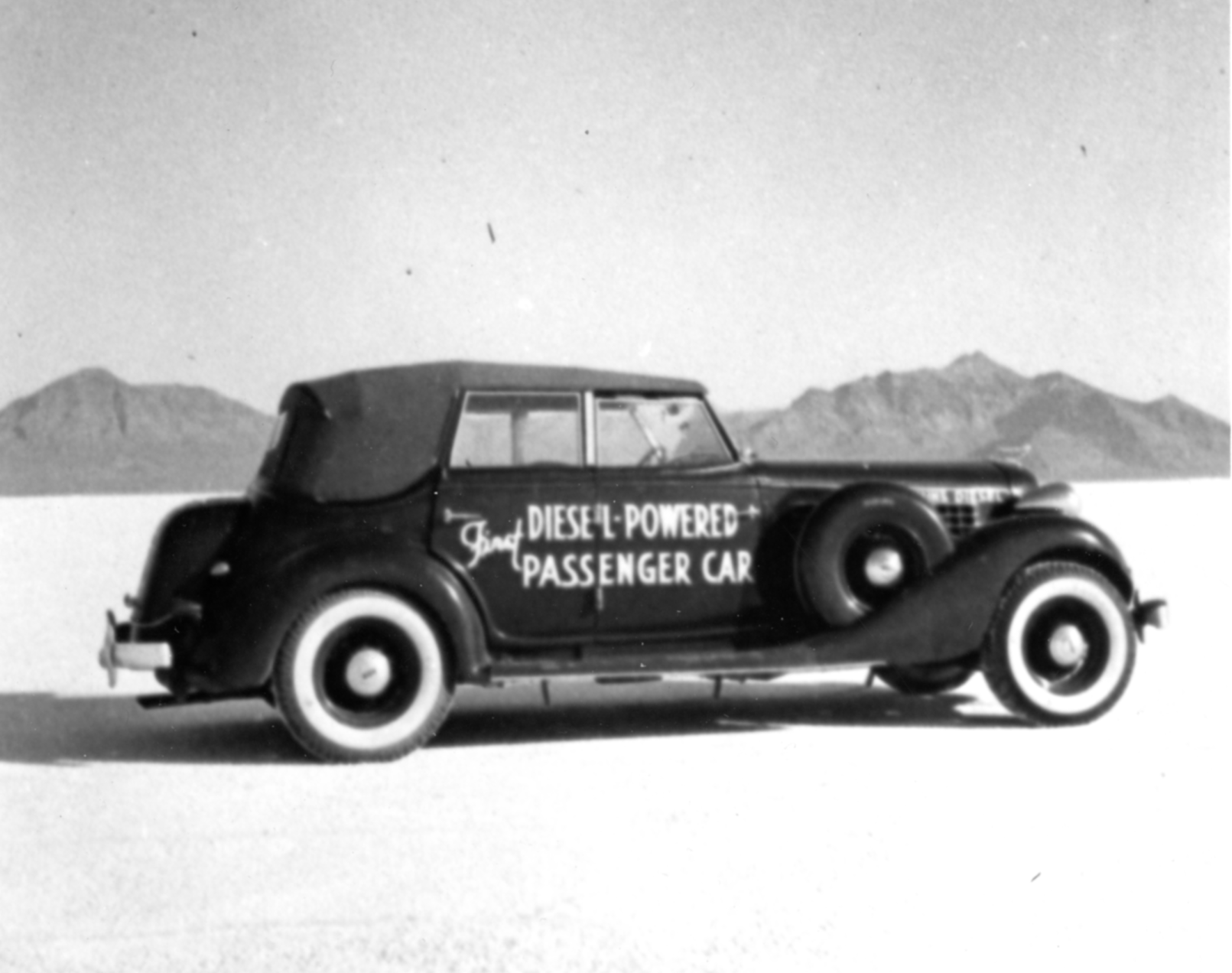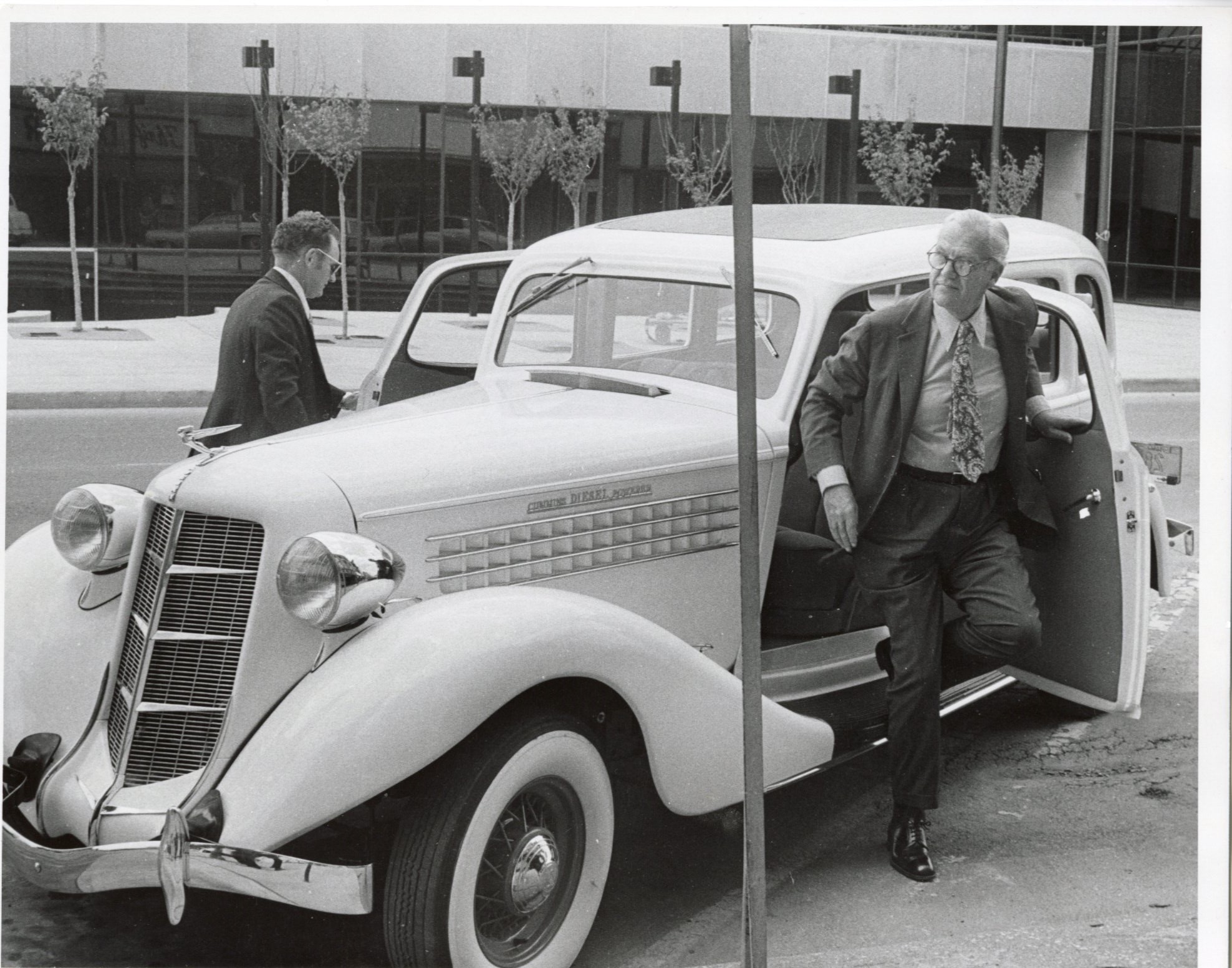Clessie Cummins' exploration of diesel's potential for passenger cars
By Tamra Knudsen, Brand Journalist

Clessie Cummins is known for improving existing diesel engines, creating new diesel engine designs, and setting world records for endurance and speed in trucks, buses and race cars. Perhaps not as well-known are his early endeavors in promoting the efficiency of diesel power in automotive applications.
From coming up with a marketing plan promoting his Model A diesel engine in a 1935 Auburn convertible he drove cross-country, to removing and replacing a gas engine in a 1936 Cadillac convertible for a much needed trip to Florida, the innovator was diesel-driven and determined to demonstrate the efficiency and practicality of using diesel in a variety of applications.

The JOURNEY OF THE AUBURN
In 1935, with no diesel-powered passenger cars in production at the time, Cummins Inc. briefly collaborated with Auburn Automobile Company to install a prototype Cummins Model A 6-cylinder diesel in a 1935 Auburn. Using an aluminum block and head for a much lighter engine than typical cast-iron diesel engines, the innovative new engine provided fuel efficiency by getting better mileage using less expensive fuel: diesel compared to a gasoline counterpart, with diesel being less than half the price of gasoline.
In May 1935, Cummins began discussions with Auburn Automotive Company to create diesel-powered passenger vehicles. Auburn wanted to take advantage of growing interest in diesel powered vehicles and Clessie Cummins wanted to embark upon another marketing stint to promote diesel for automotive applications. The engine was to be a new Model A, which Cummins had already begun production on in 1934, specifically designed for passenger car applications. Two prototypes were made from an aluminum alloy to reduce weight and be comparable to the gasoline counterpart.
Auburn and Cummins agreed to a cross-country leisurely trip, unlike timed trips of the past, to demonstrate this family-friendly, diesel-powered car. Cummins was to leave on a publicity trip from New York City to Los Angeles with a Paramount News crew filming portions of the journey. After picking out a rust-colored Auburn 851 4-door convertible at the Auburn Connersville, Indiana, plant, the all-aluminum Model A engine was installed in the car at the Cummins Engine Plant in Columbus with little modification to the car's firewall.
On June 17, 1935, Cummins left New York City for Los Angeles, making publicity stops along the way. At Salt Lake City, Cummins drove the car on the Bonneville course, clocking over 100 mph. Near Las Vegas, Cummins stopped at the Hoover Dam, which was under construction, to get footage of the car driving across the dam. And, on July 4th, Cummins arrived at Los Angeles, making a stop at Warner Bros. Studio. Cummins travelled 3,774 miles, averaging 35 mpg, with a total fuel cost of $7.63.
Here’s a link to the Paramount newsreel about Clessie’s trip in the Auburn.
Upon returning to Columbus, Cummins personally used the Auburn until 1937 when, during a trip to Madison, he was cut-off by a Model T Ford and wrecked the vehicle to avoid collision. The car was scrapped but the engine survived.
Under contract with Auburn in 1936, Cummins was to repower eight base model 4-door sedans designed to house the Model A engine. Due to a U.S. Securities and Exchange Commission investigation of questionable stock practices by Auburn Automobile Company, Cummins cancelled the contract but kept the eight sedans. Following the wreck in 1937, Cummins installed the same engine into one of the eight sedans. It is this car, today's white 1935 Auburn 655 sedan, which remains as one of the first pre-production prototypes of a diesel-powered automobile.
Cummins drove the Auburn until 1939. It was eventually put into storage. In 1974, it was rediscovered in a lumberyard warehouse south of today's Columbus Engine Plant. The Auburn underwent a complete restoration, with the engine only requiring minimal work. In the same year, the Auburn 655 was presented to J. Irwin Miller, then Chairman of Cummins Engine Company, as his 40th anniversary gift.

THE CADILLAC’S EXCURSION TO FLORIDA
Cummins' health raised concern in 1938 and his doctor ordered him to take a trip south for rest and relaxation. He planned a trip to Ft. Myers Beach, Florida, with his family, but not before he fitted his vehicle with a diesel engine for the long drive.
Cummins believed in his diesel engine so much that he swapped out the stock L-head V-12 gas engine in his 1936 Cadillac Series 72 Convertible with a Cummins Model A 331 cubic inch in-line 6 diesel engine. This was a 'hurry-up' installation, with Cummins opting for a production cast iron block Model A engine instead of the prototype all aluminum Model A engine from the Auburn. The used Cadillac with the beefy suspension, sturdy X frame, and just enough engine bay space allowed for the installation to happen with minimal changes to the car itself. Cummins did decide to install a second fuel tank.
In November, as the Cummins family headed south, Thane Houser, Cummins' chief engineer, followed them with tools and spare injectors on the first leg to Kentucky. Seeing no issues, Cummins and his family continued to Florida. First fuel stop was not until Georgia. They then made the remainder of the trip to Fort Myers without an additional fuel stop. Cummins was proud of the fuel economy and would boast about this. On one such occasion, after Cummins was explaining only one fuel stop was needed on the way down from Columbus, Cummins' youngest son, Lyle, piped up to say that the auxiliary fuel tank under the back seat sure helped. A sharp look of disapproval from Cummins to Lyle was all that was needed to let Lyle know that he was in big trouble!
WHERE ARE THEY NOW?
The Auburn and Cadillac are both on display at the Cummins Heritage Center, located at the Cummins Engine Plant in Columbus where visitors can get up close, appreciate their beauty and learn about their place in Cummins' long history. And they do make appearances at various car shows where car enthusiasts can hear about their history from Cummins' volunteers, appreciate their pristine appearance, and snap a shot of history for their archives!

Author Profiles

Tamra Knudsen, Brand Journalist
Tamra Knudsen is a Brand Journalist for Cummins with extensive experience in the Capital Goods sector, serving over 20 years in various corporate communications roles. She began her career in accounting, moving into numerous positions within finance, marketing and administration, until she discovered her niche in the field of communications. Her passion is to create transparent and meaningful content that educates, informs and engages readers on a variety of topics for both external and internal audiences. Tamra graduated from the University of Wisconsin, Parkside, with a BS in Business Administration and Management.
Temas relacionados